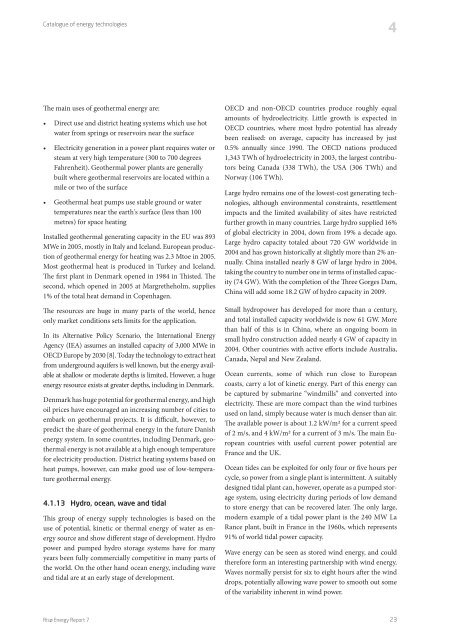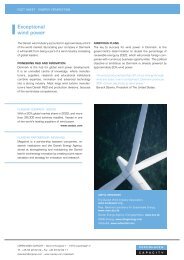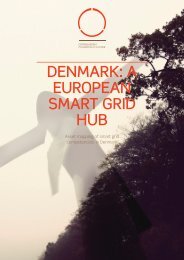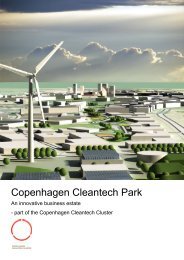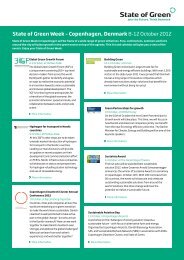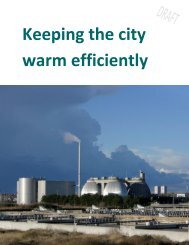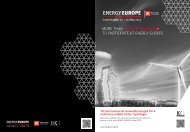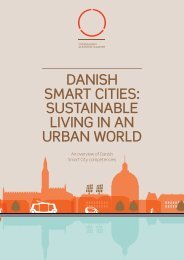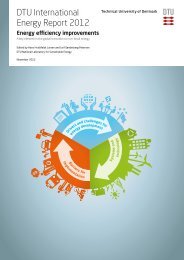Future low carbon energy systems - Copenhagen Cleantech Cluster
Future low carbon energy systems - Copenhagen Cleantech Cluster
Future low carbon energy systems - Copenhagen Cleantech Cluster
Create successful ePaper yourself
Turn your PDF publications into a flip-book with our unique Google optimized e-Paper software.
Catalogue of <strong>energy</strong> technologies4The main uses of geothermal <strong>energy</strong> are:water from springs or reservoirs near the surfacesteam at very high temperature (300 to 700 degreesFahrenheit). Geothermal power plants are generallybuilt where geothermal reservoirs are located within amile or two of the surfacetemperatures near the earth's surface (less than 100metres) for space heatingInstalled geothermal generating capacity in the EU was 893MWe in 2005, mostly in Italy and Iceland. European productionof geothermal <strong>energy</strong> for heating was 2.3 Mtoe in 2005.Most geothermal heat is produced in Turkey and Iceland.The first plant in Denmark opened in 1984 in Thisted. Thesecond, which opened in 2005 at Margretheholm, supplies1% of the total heat demand in <strong>Copenhagen</strong>.The resources are huge in many parts of the world, henceonly market conditions sets limits for the application.In its Alternative Policy Scenario, the International EnergyAgency (IEA) assumes an installed capacity of 3,000 MWe inOECD Europe by 2030 [8]. Today the technology to extract heatfrom underground aquifers is well known, but the <strong>energy</strong> availableat shal<strong>low</strong> or moderate depths is limited, However, a huge<strong>energy</strong> resource exists at greater depths, including in Denmark.Denmark has huge potential for geothermal <strong>energy</strong>, and highoil prices have encouraged an increasing number of cities toembark on geothermal projects. It is difficult, however, topredict the share of geothermal <strong>energy</strong> in the future Danish<strong>energy</strong> system. In some countries, including Denmark, geothermal<strong>energy</strong> is not available at a high enough temperaturefor electricity production. District heating <strong>systems</strong> based onheat pumps, however, can make good use of <strong>low</strong>-temperaturegeothermal <strong>energy</strong>.4.1.13 Hydro, ocean, wave and tidalThis group of <strong>energy</strong> supply technologies is based on theuse of potential, kinetic or thermal <strong>energy</strong> of water as <strong>energy</strong>source and show different stage of development. Hydropower and pumped hydro storage <strong>systems</strong> have for manyyears been fully commercially competitive in many parts ofthe world. On the other hand ocean <strong>energy</strong>, including waveand tidal are at an early stage of development.OECD and non-OECD countries produce roughly equalamounts of hydroelectricity. Little growth is expected inOECD countries, where most hydro potential has alreadybeen realised: on average, capacity has increased by just0.5% annually since 1990. The OECD nations produced1,343 TWh of hydroelectricity in 2003, the largest contributorsbeing Canada (338 TWh), the USA (306 TWh) andLarge hydro remains one of the <strong>low</strong>est-cost generating technologies,although environmental constraints, resettlementimpacts and the limited availability of sites have restrictedfurther growth in many countries. Large hydro supplied 16%of global electricity in 2004, down from 19% a decade ago.Large hydro capacity totaled about 720 GW worldwide in2004 and has grown historically at slightly more than 2% annually.China installed nearly 8 GW of large hydro in 2004,taking the country to number one in terms of installed capacity(74 GW). With the completion of the Three Gorges Dam,China will add some 18.2 GW of hydro capacity in 2009.Small hydropower has developed for more than a century,and total installed capacity worldwide is now 61 GW. Morethan half of this is in China, where an ongoing boom insmall hydro construction added nearly 4 GW of capacity in2004. Other countries with active efforts include Australia,Ocean currents, some of which run close to Europeancoasts, carry a lot of kinetic <strong>energy</strong>. Part of this <strong>energy</strong> canbe captured by submarine “windmills” and converted intoelectricity. These are more compact than the wind turbinesused on land, simply because water is much denser than air.The available power is about 1.2 kW/m2 for a current speedof 2 m/s, and 4 kW/m2 for a current of 3 m/s. The main Europeancountries with useful current power potential areFrance and the UK.Ocean tides can be exploited for only four or five hours percycle, so power from a single plant is intermittent. A suitablydesigned tidal plant can, however, operate as a pumped storagesystem, using electricity during periods of <strong>low</strong> demandto store <strong>energy</strong> that can be recovered later. The only large,modern example of a tidal power plant is the 240 MW LaRance plant, built in France in the 1960s, which represents91% of world tidal power capacity.Wave <strong>energy</strong> can be seen as stored wind <strong>energy</strong>, and couldtherefore form an interesting partnership with wind <strong>energy</strong>.Waves normally persist for six to eight hours after the winddrops, potentially al<strong>low</strong>ing wave power to smooth out someof the variability inherent in wind power.Risø Energy Report 723


